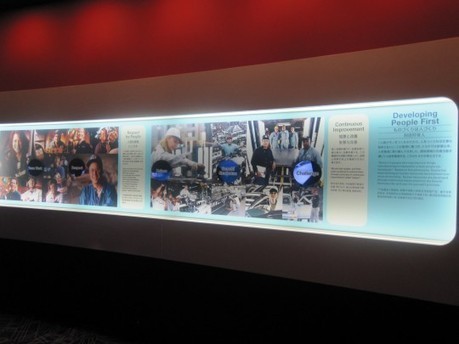Feb 26 2013
Toyota, Respect for People and Lean | Mark Graban
See on Scoop.it – lean manufacturing
Blog post at Lean Blog : A principle that has been often discussed (and hopefully practiced) in the Lean community over the past few years is usually described as “respect for people.” A certain British rabble rouser recently said at a Lean conference “all this respect for people stuff is horse sh*t,” and that it is a “conventional Western management interpretation.” He mocked the idea of “respect for people programs,” although I’m not sure where such a standalone program has ever been attempted.
Ignoring complaints about minor safety issues, like sharp edges on a cart, is also showing disrespect.There are many such issues that must be addressed before asking people to participate in improvement and contribute ideas.The Frank Woollard quote in Bob Emiliani’s comment explains why you should pay respect to your people. It’s not about being nice. In the long run, you cannot compete unless your organization fires on all intellectual cylinders.
See on www.leanblog.org


Feb 26 2013
New assembly methods at Toyota
Toyota’s latest plants in Ohira, in Japan’s Miyagi prefecture and in Tupelo, Mississippi, feature new approaches to assembly. According to press reports, the Miyagi plant is small, with 900 employees making 250 cars/day for export to the US, with a plan to double output and employment. It was designed to require a minimal investment and be easy to change. The plant started operations shortly before the Fukushima earthquake and, even though it is the Northern part of Japan that was most affected, it resisted well and was able to resume operations about six weeks later.
This is how Barry Render described it:
Toyota is not providing details, but I have been able to glean some information about it from the press and Barry Render’s blog, on the following features:
This is followed by a few conclusions.
Side-by-side assembly
I have seen side-by-side assembly at the Volvo Bus factory in Turku, Finland. In the picture of the building below, bus bodies are assembled in the hall on the left, side-by-side under they are mounted on a chassis and move forward on their wheels, laid out front to back in the hall you see in the background.
The ratio of width to length is more favorable to this arrangement for buses than for cars. A straight assembly line with a front-to-back arrangement throughout would require a long and narrow building and a snaking line would have problematic turnarounds. With cars, the side-by-side arrangement seems suitable for work done at the front or the back of the car, such as installing headlights or bumpers. but less for work that requires access from the middle, such as installing instrument panels or upholstery. The following press picture (AP), however, shows an assembly operation done inside the car body in what appears to be a side-by-side layout. It implies that space for the part cart must be provided between cars, which forces them apart.
None of the available pictures from the Miyagi plant shows the raku-raku seat that was a prominent feature of the early 1990s designs and made it easier for operators to work inside the car bodies. Not only is a raku-raku seat an added investment, but it is also easier to use in a front-to-back than in a side-by-side layout.
Modular paint booths
I could not find pictures or sketches of the Miyagi painting system. Following is how CNN Money described it on 2/18/2011:
Friction roller conveyors
Following is how CNN Money described the Miyagi conveyor systems on 2/18/2011:
Note that the sketch shows car bodies without wheels. In this system, the bar supporting the cars forms
A photographs of final assembly at Ohira shows operations done further downstream, with the wheels on:
In this picture, the floor the operators stand on is flush with the assembly line, meaning that it is either a classical line with the drive mechanism in a pit under the floor, or the operators are in a raised platform spanning the length of this assembly line segment.
Elevated platform versus suspension conveyor
The following photographs contrast the suspension conveyor approach as previously used at Toyota with the elevated platform at Tupelo, Mississippi:
From these pictures, it is clear that the elevated platform is a cheaper system to build, but I can see two issues with it:
Conclusions
The journalists take on the Ohira plant is that it is intended to prove a design for low-volume, low-cost, high-labor content plants that can be deployed easily in emerging economies with small markets. The designs of the early 1990s instead used more automation to make the work easier for an aging work force, with tools like the raku-raku seat. This is a different direction, addressing different needs. But why build it in Northern Japan rather than, say, the Philippines? It shows Toyota’s commitment to domestic manufacturing in Japan, and it is easier to test and refine the concept locally than overseas.
Share this:
Like this:
By Michel Baudin • Technology 29 • Tags: industrial engineering, Lean assembly, Manufacturing engineering, Toyota, Toyota Production System, TPS